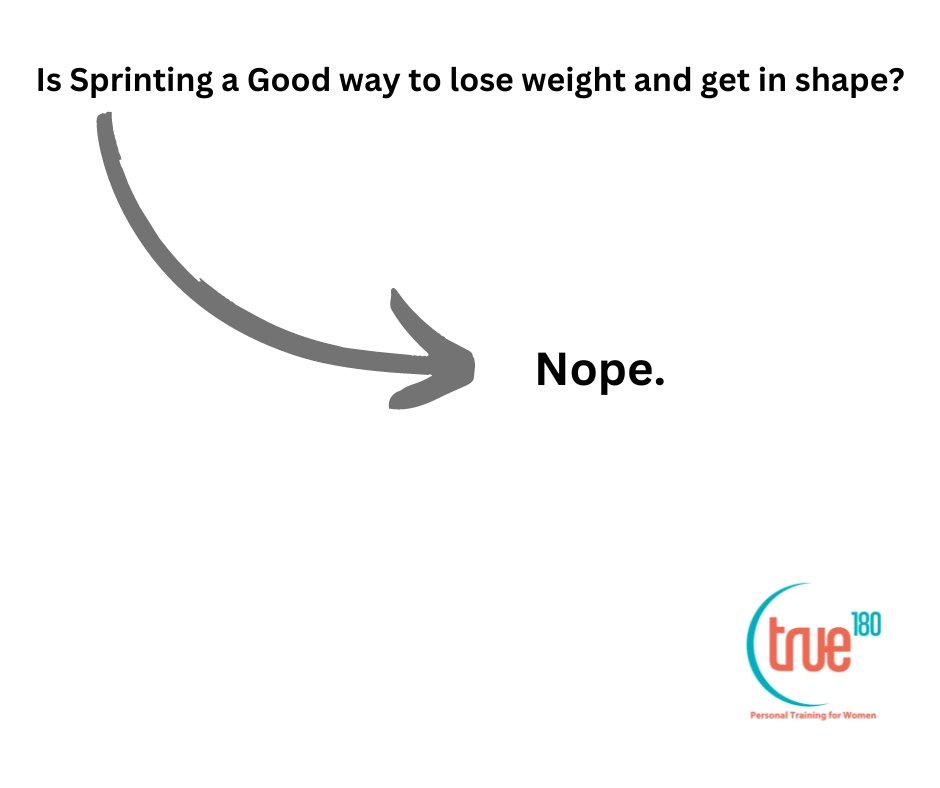Lose Weight and Get in Shape! That’s what most people are looking for when they wonder if sprinting is the answer for them. Word on the internet is that sprinting will give sedentary office workers the body of an Olympic sprinter in just 12 weeks and in just 20 minutes a workout.  (eye roll!)
(eye roll!)
So, here are some facts and what is probably a much better option for you...
Is Sprinting a Good way to lose weight and get in shape?
The word on the internet is that sprinting is (1) time efficient exercise that (2) boosts your metabolism for days and (3) will give you the body of an elite sprinter in just 12 weeks. Reality is pretty much the opposite.
Sprinting is time consuming, burns very few calories overall and, for the record, only the genetics, and the lifetime of full time training will give anyone the body of an elite sprinter.
Time Consuming or Time Efficient?
Most normal to very fit people can only sprint for 10 to 30 seconds at a time. (We’re talking about sprinting not jogging fast. Sprint effort is what the claims on the internet are about.). To repeat that same effort requires anywhere from 2 to 10 min of rest. It’s also exhausting. Uniquely and extremely exhausting.
In other words, you’d be lucky to cover 1 mile (1,600 meters) in a 40-60 min sprint-based workout.
Whereas you could’ve walked 2 to 4 miles in the same time. The walking would burn more calories overall. The walking would also be pretty easy to recover from. If you walk 3 miles several times per week, then walking 3 miles today won’t send you to bed and make your legs semi-useless for 3 days. With sprinting it seems to be just as exhausting even if you are doing it regularly.
Metabolic Boost?
I’m embarrassed to say that I have repeated this nonsense to clients many times over my career*. By “this nonsense” I mean the myth that high intensity exercise (such as sprinting) elevates your metabolism so much and for so long that anything else is pointless. The devil is in the details.
Let’s use the example above: 40 minutes of walking – vs – sprinting where we generously assume 1,600 meters (1 mile) of sprint work with a 150 pound woman. The mile of sprinting will burn 113 calories. The 2 miles of walking 166.
The metabolic boost of all exercise occurs via EPOC. EPOC is excess post exercise oxygen consumption, or the “after burn.” Low to moderate intensity exercise yields a 7% boost in total calories expended, and extremely high intensity activity yields up to a 14% boost in total calories burned.
If we add in the after burn of sprinting, our exhausted 150 lady will have burned 148 calories. Our walker will have burned 178 calories. If our walker had worn a 20 pound vest (vests are the bests!) she would’ve burned 201 calories if you include EPOC.
*In my defense, multiple presenters, researchers and textbooks over many years encouraged my belief in said nonsense… and, also, it is still my brain.
Bottom Line
When it comes to getting your steps in (or cardio, or NEAT, or whatever you’d call it) low to moderate activity is a winner because you can do more of it, more often without crushing your energy level. Sprinting burns more calories per mile, but it requires so much rest and is so taxing that you can’t do enough of it to match the calorie burn of walking at a moderate pace. You also can’t do a soul crushing sprint workout every day. Whereas you can walk daily, and that walking will generally help your legs recover faster from your strength workouts.
Happy Walking!

